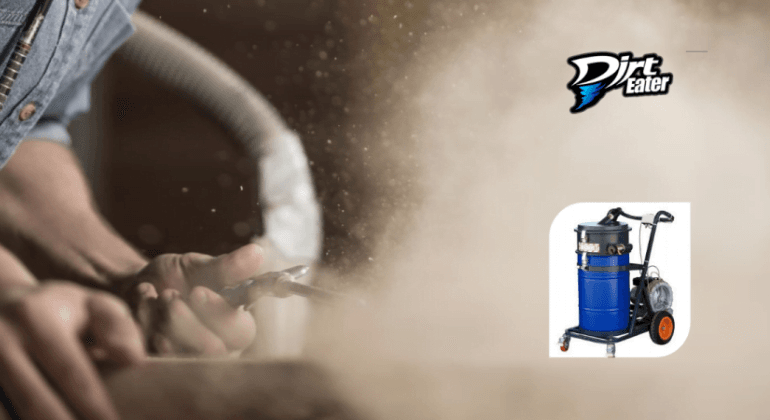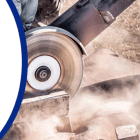Between 2006 and 2017, 111 combustible dust incidents resulted in 66 worker deaths and 337 injuries in the United States, according to data from the Chemical Safety Board.
Compressed air is a common source of compressed air that can cause explosions if combustible dust is present, but other sources include:

What is combustible dust?
Combustible dust is a fine powder that ignites with air and burns rapidly. The hazard of combustible dust exists when the following conditions are present:
- Exposure to ignition sources such as flame, sparks, or hot surfaces (e.g., equipment)
- Inert material used for auxiliary purposes such as packaging, transport containers, or storage bins
- Sufficient quantity of the inert material to create an explosive or ignitable mixture
Combustible dust examples
Some examples of combustible dust include:
- Wood, such as molding, plywood, and particleboard
- Coal and coke
- Flour and grain (such as wheat)
- Cocoa beans and sugar
So, what is a combustible dust explosion? How do they happen, and what can be done to prevent them?
Common causes of combustible dust explosions
Combustible dust can be present in many different industries, including:
- Agriculture. Dust from grain storage or handling operations can contain organic and other materials that will burn explosively.
- Foundries and metal casting plants. These operations produce large amounts of metal dust that are highly flammable when suspended in air and heated to ignition temperatures by furnaces or other heat sources, such as electric arcs between two pieces of metal equipment.
- Pharmaceutical manufacturing facilities. Products such as powdered sugars and starches are used for making tablets for food products or dosage forms for medications; these powders may also become combustible if they are finely ground (as when making a tablet).
How Do Combustible Dust Explosions Occur?
Combustible dust explosions require the presence of five (5) elements. If one of those elements is not present, it will not occur.
The fire triangle is made up of three elements, while the dust pentagon contains five.
- Fuel to burn
- Oxygen
- Ignition source
- Combustible dust dispersion in the air in a certain concentration
- Confinement of the combustible dust cloud
If you monitor and control these elements, combustible dust explosions will not occur.
OSHA standards for explosive dust safety
OSHA has several standards that address combustible dust explosions. They include:
- 1910.272 – Hazardous Waste Operations and Emergency Response (HAZWOPER)
- 1910.1001 – Combustible Dust, Finely Divided Metals and Mixtures with Potential for Explosion; Control Methods
- 1926.55 – Respiratory Protection Program Standards
- 1910.106 – Prevention of Fires and Explosions in Wood Processing and Woodworking Facilities
- 1910.109 – Occupational Safety and Health Administration (OSHA) Construction Standards
The dangers
Five elements must be present for a combustible dust explosion to occur: fuel, oxygen, an ignition source, dispersion, and confinement.
“Dust may accumulate on surfaces and lie undisturbed for years,” the agency states. “Then an initial fire or explosion, known as a primary event, shakes it loose and it ignites.” The resulting pressure then travels throughout a plant or factory and dislodges dust that has been lying dormant, serving as fuel for a secondary explosion. “Most of the fatalities and the devastating injuries have been caused by these secondary dust explosions,” CSB notes.
Safety measures
Good housekeeping is a crucial first step toward mitigating dust explosion hazards. “Research has shown that facilities that are well-maintained experience fewer fires, explosions, and other accidents, and are more profitable as well,” OSHA states. The agency offers additional tips on combustible dust safety:
- Implement a hazardous dust control program that includes dust inspection, testing, and housekeeping.
- Equip your facility with proper dust collection systems and filters.
- Regularly inspect both open and hidden areas for dust residue. If ignition sources are found, use cleaning methods that don’t generate dust clouds.
- Use vacuum cleaners specifically approved for dust collection.
- Ensure employees are trained on the hazards of combustible dust.
Using proper electrical equipment in hazardous locations is crucial to eliminating common ignition sources, OSHA states. Tips on controlling ignition sources include:
- Ensuring appropriate electrical equipment and wiring methods are used.
- Having an ignition control program, such as grounding and bonding and other methods, for dissipating any electrostatic charge that could be generated while transporting dust through ductwork.
- Controlling the use of open flames and static electricity. Don’t allow smoking.
- Keeping heated systems and surfaces away from combustible dust.
Conclusion
In this post, we’ve outlined the dangers of combustible dust explosions and how you can protect yourself from them. We hope that taking these precautions into consideration when planning your facility’s layout, equipment selection and maintenance, and cleaning procedures will help keep your workers safe. Remember: safety is always the most important thing!







